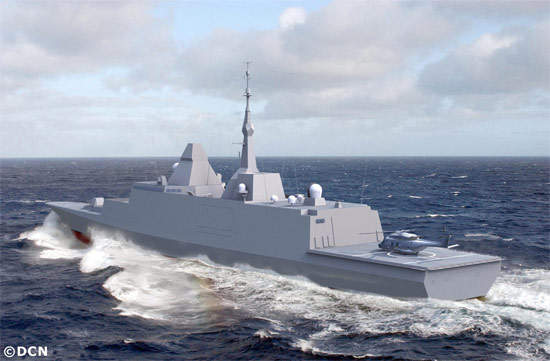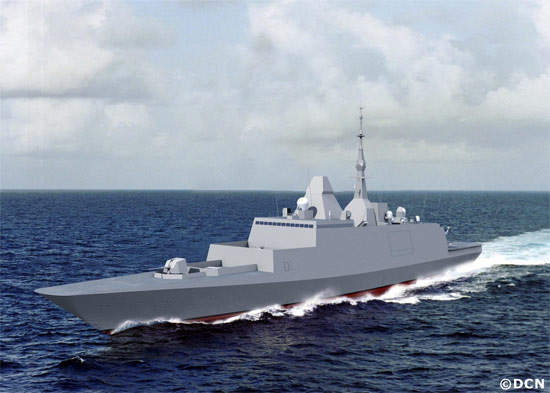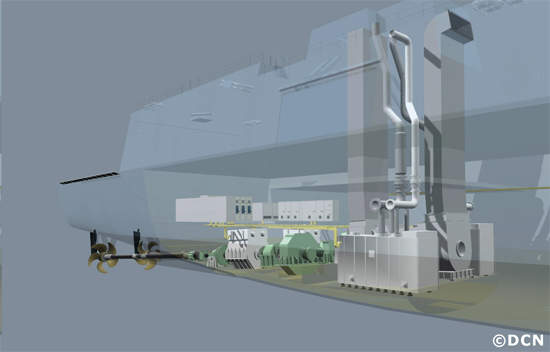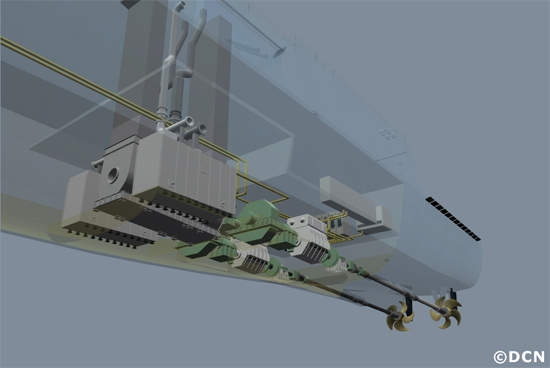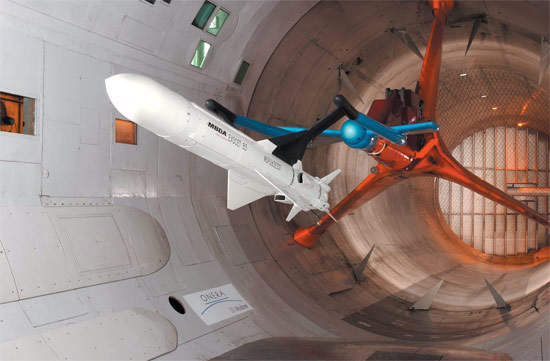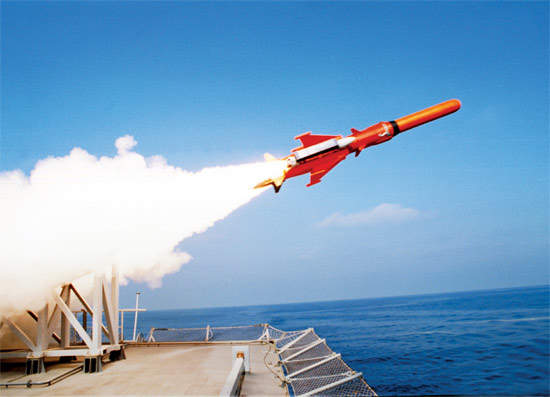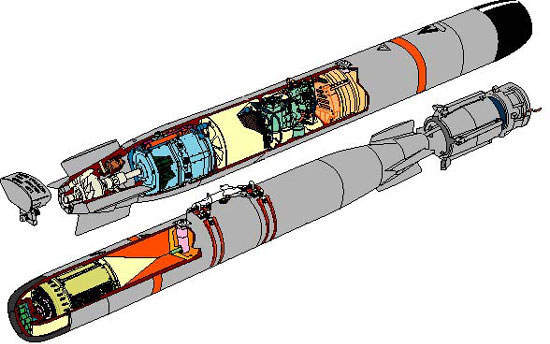The FREMM European multi-mission frigate is a joint programme between France and Italy. It will build 21 FREMM frigates for the French Navy and the Italian Navy. The frigates are 140m in length and 20m wide with a 6,000t displacement. The ship can hold 108 officers and crew.
Prime contractors for the FREMM programme are Armaris of France and Orizzonte Sistemi Navali of Italy.
Armaris was a joint subsidiary of DCN and Thales and is now wholly owned by DCNS. The Italian Orizzonte Sistemi Navali is a joint venture (JV) between Fincantieri and Finmeccanica.
Amaris and Orizzonte play major roles in the system specification and development of the main subsystems and the combat system.
In April 2007, DCN became DCNS (now Naval Group). This followed an agreement where Thales became a 25% shareholder in the new company and DCN acquired the naval business of Thales France (excluding naval equipment).
Development and design features of the frigates
In November 2005, the organisation conjointe de cooperation en matière d’armement (OCCAR) awarded French companies DCN and Thales and Italian companies Fincantieri and Finmeccanica the first FREMM development and build contracts.
The first contract covers the design-build and support of the first six anti-submarine warfare frigates and two land-attack frigates for the French Navy. Three more frigates were ordered by the French Government in October 2009.
Construction of the first in class vessel Aquitaine began in March 2007 and was launched in April 2010. Aquitaine began sea trials in April 2011 and was delivered to the French Navy in November 2012.
The other seven frigates ordered by OCCAR for the French Navy are Aquitaine, Provence, Languedoc, Auvergne, Bretagne, Normandie, Alsace and Lorraine.
DCNS started construction of Provence in December 2010. The frigate was launched in September 2013 and began sea trials in October 2014. It was delivered to the French Navy in June 2015.
Construction of Languedoc started in September 2011 and launch took place in July 2014. The frigate was delivered to the French Navy in March 2016. Auvergne was laid down in August 2012. The frigate was launched in September 2015 and was delivered in April 2017. Bretagne was floated in September 2016. Normandie was laid down in February 2018.
The final two frigates Alsace and Lorraine are currently under construction, with delivery scheduled for 2022.
The Ministry of Defence of the Arab Republic of Egypt placed an order with DCNS for a FREMM frigate, Tahya Misr, in February 2015. The frigate was delivered to the Egyptian Navy in June 2015.
In May 2006, OCCAR awarded the contract for the first two Italian FREMM frigates. Italy ordered a second batch of four submarines in February 2008, with three being designated for anti-submarine warfare (ASW). The last two were ordered in April 2015.
The first Italian frigate was launched in July 2011 and delivered in May 2013. Deliveries are expected to conclude in 2021. The first of the class is Carlo Bergamini, which was launched in July 2011 and delivered in 2013.
The second vessel of the class, Virginio Fasan, was launched in March 2012 and delivered in December 2013. The third ship, Carlo Margottini, was delivered in 2014. Carabiniere was the fourth ship to be delivered in April 2015.
The fifth frigate, Alpino, was launched in December 2014 and the sixth, Rizzo, was launched in December 2015. Rizzo was delivered in April 2017, while the seventh frigate Federico Martinengo was launched in March 2017 and delivered in April 2018.
First steel was cut for the eighth FREMM frigate in February 2015 and the vessel was launched in February 2018.
The ninth FREMM frigate Spartaco Schergat was launched in January 2019 and is scheduled to be delivered in 2020.
In February 2018, the US Navy awarded a $15m concept design contract to Fincantieri’s subsidiary Marinette Marine to evolve the FREMM design into new-generation frigates for its FFG(X) programme.
Australia shortlisted FREMM frigates for its Project Sea 5000 Future Frigate in September 2017.
The French Navy sold two FREMM frigates, Tahya Misr (initially named Normandie) and Mohammed VI, to Egypt and Morocco respectively.
In October 2007, DCNS announced an agreement was signed with the Royal Moroccan Navy for the supply of one FREMM frigate, the first export order for the vessel.
Construction of a FREMM frigate for Royal Moroccan Navy began in 2008. The frigate was launched in September 2011 and began sea trials in April 2013. It was delivered in January 2014.
The frigate’s layout was designed to provide sufficient size for operational effectiveness, maintainability and sustained upgrades. The layout incorporates increased headroom between decks, deeper and longer engine compartments and larger equipment pathways for access and maintenance.
For quayside maintenance, the frigate is fitted with an aft side door for loading and unloading equipment, load handling equipment and a wide lower deck passageway. Consoles on the integrated bridge are for all main platform functions, including navigation, steering and communications.
The bridge allows operators to manage and control all platform systems, as well as to monitor safety and security and to coordinate other operations.
Italian FREMM frigate specifics
The Italian frigates are armed with the SAAM Aster 15 missile system for air-defence capability and also Teseo Mk2 (export version – Otomat Mk2) sea-skimming anti-ship missiles, both supplied by MBDA.
Teseo Mk2 uses command-updated inertial guidance and has a range of up to 55km. Two DCNS Sylver A43 vertical-launch systems are fitted to each ship.
Frigates are equipped with MBDA’s Milas all-weather anti-submarine warfare weapon system. Milas, a derivative of Otomat Mk2, carries and releases a lightweight torpedo such as an MU-90 close to the designated hostile submarine. The submarine’s position is indicated by the ship’s sonar or by other assets such as an ASW helicopter or maritime patrol aircraft.
The vessel’s sonar suite includes Thales Type 4110 hull-mounted sonar. The three anti-submarine warfare vessels are also equipped with Thales Type 4929 active very-low-frequency towed array sonars.
The EMPAR G-band multifunction phased-array radar from Selex Sistemi Integrati is the fire control radar for the missile systems. The vessel’s infra-red search-and-track (IRST) system is the Galileo Avionica silent acquisition surveillance system (SASS).
French FREMM frigate details
The French frigates are being built in two-mission versions – the land-attack (action vers la terre or AVT) version that is being fitted with torpedoes and vertically launched self-defence and cruise missiles, as well as an anti-submarine warfare ASW version fitted with torpedoes, vertical launch self-defence missiles and an active towed array sonar.
Sensors, command and control
Thales is responsible for the development and supply of the French FREMM surveillance and communications suites.
Systems will include Thales Artemis infra-red search-and-track (IRST) system and the Herakles 3D S-band multifunction surveillance and fire control radar for the frigates’ anti-air weapons systems.
Artemis is based on medium-wave staring focal plane arrays and uses multiple static sensor heads rather than mechanical scanning. Herakles has a range of 250km against air targets and 80km against surface targets.
The upgradeable high-performance combat system by DCN and Thales is based on a high-speed data network. The combat system architecture will enable future weapon systems to be integrated into the frigates.
The ship’s Nato standard external communications include Link 11, Link 16, Link 22 and JSAT tactical data links, allowing full interoperability with Nato forces.
Internal communications include messaging, conventional and wireless telephony, public address, closed-circuit television, as well as internet and intranet ports.
Italian FREMMs are fitted with Sagem’s (Safan Group) Sigma 40 inertial navigation system.
Missile variations and weaponry
For anti-ship capability, the French FREMMs are being armed with MBDA’s Exocet MM40 block three anti-ship missiles. These will be controlled via a CMS multifunction console by a Mer-Mer weapon control system. Block three missiles have longer range and an enhanced navigation system to give a littoral attack capability.
The MBDA Aster 15 air defence missile system for the AVT and ASW French frigates provides protection against supersonic and subsonic threats. Aster 15 has a minimum range of 1.7km and a maximum range of 30km against subsonic airborne threats.
MBDA Scalp Naval vertically launched cruise missile provides the French AVT FREMM’s land-attack capability.
MBDA was awarded a contract for the first batch of 50 Scalp missiles for FREMM frigates in January 2007.
The Sylver A-70 vertical launcher was developed by DCN Ruelle. The missiles use inertial guidance and electro-optical terrain contour matching (TERCOM) in the terminal target approach phase of flight. Scalp Naval has a range of more than 1,000km.
The French FREMM’s main gun is the Oto Melara medium-calibre 76/62 Super Rapide naval gun. The gun interfaces to an optronic fire control system and is controlled via a CMS multifunction console or through a visual weapons director on the bridge. Four 12.7mm machine guns are installed for close-in defence.
Torpedoes and countermeasures of the multimission frigates
French vessels are armed with the Eurotorp MU 90 Impact torpedo. MU 90 has a directed energy warhead and a range of 12,000m at maximum speed and 25,000m at minimum speed.
Thales developed the integrated electronic warfare suite. Sagem was awarded a contract for the new-generation Dagaie system (NGDS) decoy system in January 2007.
Aircraft landing deck of the European vessels
The frigate has an aft helicopter hangar and deck of approximately 520m². The frigate is fitted with emergency communication and remote briefing system with the ship’s helicopter. The French AVT frigates are fitted for a tactical unmanned air vehicle (TUAV). The AVT FREMM also has the capability to control long-endurance, medium and high altitude (MALE and HALE) unmanned air vehicles launched from ground sites or from other platforms.
Italian vessels are being fitted with the TC-ASIST helicopter handling system from Curtiss-Wright Controls of Charlotte, North Carolina.
Both the French and Italian frigates have gas turbines with two shafts driving fixed-pitch propellers.
In March 2006, Avio of Italy was awarded the contract to supply the FREMM power plant for both countries, which will be the LM2500+G4 gas turbine, licensed-built from General Electric, which will provide 32MW of power.
The maximum speed is 27k. For quiet yet efficient anti-submarine operations, the shafts are driven by electric motors and the frigate’s speed in ASW silent mode is up to 15k.
An azimuth thruster provides precision manoeuvring for quayside and harbour operations, station keeping and as a back-up emergency propulsion system.

